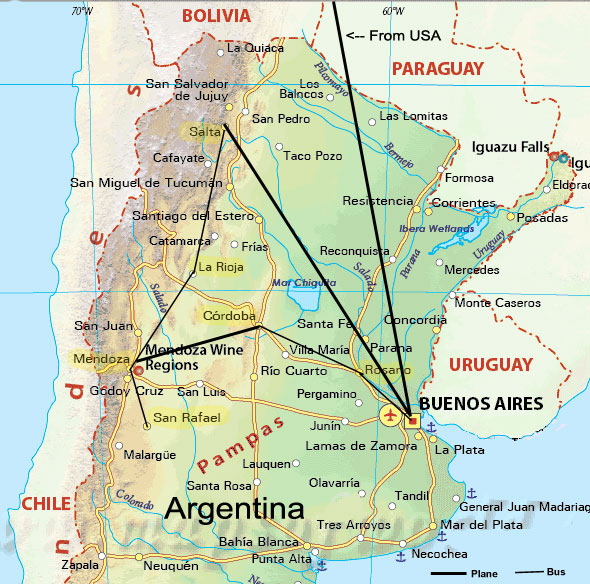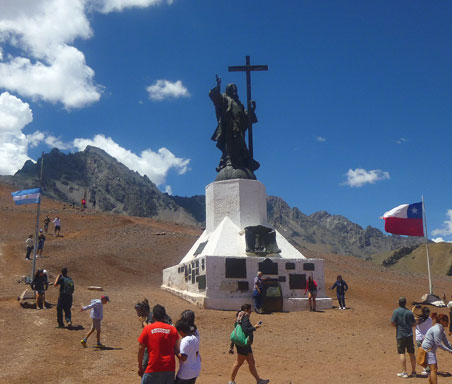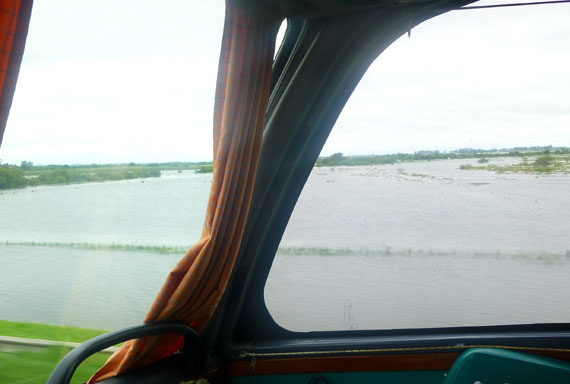Finding Summer in Argentina
![]()
Part of our work during our stay in Puerto Vallarta, was to make plans for the next big journey. Wishing to avoid the winter chills soon to take over the USA, we focused on places where it was summer - the southern Hemisphere. We remembered that with reversed seasons it was summer in Argentina, and we recalled the lovely days we had spent in Buenos Aires back in 2010, so Argentina was our choice. We also recalled that this very large country has much more to offer to Nomads than big city life, so we planned our journey to explore some of the other provinces, especially those that offer grand geological and ecological places to explore. Our wish is to add another focus to our travels - to make connections with the natural world - since one of the primary reasons for cities to become more people friendly has always been to conserve more space for the rest of the flora and fauna with whom we share our planet!
 Our Argentine Journey began on December 26 when we arrived in Buenos Aires. The summer weather was quite a change from wintery Atlanta. After riding the airport bus into the city, we walked to a hostel and checked in. We then ventured out to seek a "chip" (sim card) for the phone and find some lunch. An afternoon nap enabled us to catch up on sleep and a good meal raised our spirits. We also purchased a real ticket to fly to Salta in Argentina's far Northwest for the next afternoon. We offer a map of our travels to the right.
Our Argentine Journey began on December 26 when we arrived in Buenos Aires. The summer weather was quite a change from wintery Atlanta. After riding the airport bus into the city, we walked to a hostel and checked in. We then ventured out to seek a "chip" (sim card) for the phone and find some lunch. An afternoon nap enabled us to catch up on sleep and a good meal raised our spirits. We also purchased a real ticket to fly to Salta in Argentina's far Northwest for the next afternoon. We offer a map of our travels to the right.
Salta
The city of Salta sits in the Valle de Lerme in the northwest region of the country, with the Andes Mountains and Chile to the west and Bolivia to the north. It is a major metropolitan area with a population of 700,000 friendly folks and a visitor infrastructure to provide comfortable accommodations and companies offering excursions to the special places within day trip distance.
Our first excursion took us north, crossing the tobacco and cane fields of the Valle de Lerma, continuing through the city of Jujuy and from there climbing steadily until we reached the village of Purmamarca for awesome views of the Cerro de Los Siete Colores, a wonder of geology that produced formations of rock of seven colors. From here, the road climbed more steadily through more layers of multicolored rocks, making switch backs and steep grades until we reached the top of the pass at an altitude of 4,170 meters (13,500+ feet). From there, we continued down into the vast Salinas Grandes salt flats, which extend over an area of 12,000 hectares, offering us surreal views of dazzling white salt and reflected blue of the sky.
Click here to view the Flickr photo album of our Salinas Grande Trip
Another excursion took us south through the Valle de Lerma to the tiny village of Alemania, the entrance into the canyon called Quebrada de Las Conchas. Here, the forces of wind, water and volcanic pressure over millions of years have sculpted the amazing multi-colored rocks into amazing formations, such as the Garganta del Diablo (throat of the devil), Amphitheater, and others of fantastic shapes. Finally emerging from the Quebrada, we arrived in the village of Cafayate, famous for the high altitude vineyards that enable vintners to produce the torrontes vino blanco, a new (for us) special wine that we had already enjoyed with our meals.
Click here to view the Flickr photo album of our Quebrada de Cafayate trip
Salta also offered museos and a teleferico up to the top of Cerro San Bernardo with great views over the city and to the Andes to the west. We also enjoyed the pleasant cafes around the Plaza 9 de Julio where we watched people and sipped Salta Cerveza. This frontier city offered us insights into life in a midsize Argentine city that is quite far from Buenos Aires, in both style and intensity. We celebrated Ano Nuevo, too!
La Rioja
An overnight bus ride then took us south to a smaller city, La Rioja, where we visited two wonderful museums; one focusing on archaeological finds, and the other on the folklore and 'frontier lifestyle' of the people in the region.
It was here that we first experienced the warmer than usual summer heat that Argentina is experiencing. The 104F+ (40C) degree heat chases people (including us) indoors in the middle of the day. From our air conditioned hotel room overlooking the main plaza, we noted that at 4pm, the streets were empty and people only reappeared after 6:30 or 7:00.
Mendoza
Another long bus trip took us to the vibrant city of Mendoza. We purposely traveled during the day to see the countryside and were somewhat surprised to find that most of this part of Argentina is very dry and with little vegetation, much like the desert in the southwest US. The towns that we stopped in have thrived by irrigating with the flows of the few rivers flowing from the mountains.
Mendoza is the self proclaimed 'International Capital of Wine', and therefore a place we especially wanted to visit. After enjoying Argentine wine from this area for many years, it was an essential destination. Therefore, our first excursion was a 'wine tour' that took us to visit two vineyards to learn about how wine is made and experience the much anticipated wine tasting. The contrast of the stops was intriguing; one was a small family place, while the other was a very large 'production' facility, but both produced very enjoyable wines.
 Our other essential excursion took us to the 'Alto Montana' (high mountain) up into the cordillera de los Andes. We traveled past fields of grapes near the city and then up through the canyon of the Rio Mendoza. At first, the riverbed was dry but after we passed a large reservoir, the rio ran fast, wide and mocha brown. As the road climbed, the coloring in the canyon walls became more and more dramatic, with reds, yellows, greens and blues indicating the mineral content. We stopped at Puente del Inca, the Inca Bridge, where travertine containing other minerals dissolved in thermal waters have deposited a dramatic multi-colored bridge over the river. Another stop enabled us to capture great views of Aconcaugua, the highest peak outside of the Himalayas. Just short of the border with Chile, we left the main road to climb a steep switchback track to the Christ the Redeemer statue which stands at the border. The views on to Chile and back to Argentina were incredible.
Our other essential excursion took us to the 'Alto Montana' (high mountain) up into the cordillera de los Andes. We traveled past fields of grapes near the city and then up through the canyon of the Rio Mendoza. At first, the riverbed was dry but after we passed a large reservoir, the rio ran fast, wide and mocha brown. As the road climbed, the coloring in the canyon walls became more and more dramatic, with reds, yellows, greens and blues indicating the mineral content. We stopped at Puente del Inca, the Inca Bridge, where travertine containing other minerals dissolved in thermal waters have deposited a dramatic multi-colored bridge over the river. Another stop enabled us to capture great views of Aconcaugua, the highest peak outside of the Himalayas. Just short of the border with Chile, we left the main road to climb a steep switchback track to the Christ the Redeemer statue which stands at the border. The views on to Chile and back to Argentina were incredible.
Click here to view the Flickr photo album of our Alto Montano Trip
We found the city of Mendoza to be a very pleasant place to spend some time. An earthquake destroyed the city in 1861 and the new city's shady plazas, wide streets and great street trees create a cooler atmosphere in the torrid summers. People gather each evening in Plaza Independencia, the main plaza, to enjoy the shade of the trees and the cooling effect of the great fountain.. There are cafes and restaurants all over the city, which offer a drink or a snack when needed; all are quite busy about 7:00 PM when Mendocinos stop for a drink and later for dinner. Parque San Martin dominates the west side of the city with many walking paths, a rowing lake, sports fields and a Zoo. . The bus system was quite helpful for trips around the city, once we figured out how to use it. We will definitely return to Mendoza on our next visit to Argentina.
Click here to read more about how Mendoza evolved into the city of today.
San Rafael
We traveled to San Rafael, a three hour bus ride south of Mendoza, for two reasons: to experience a smaller city reputed to be 'a small Mendoza' and to take a trip into another of Argentina's places of incredible natural beauty. In both regards, we were successful.
As hoped, the city itself was very pleasant and slower paced than Mendoza, a nice change. An excursion took us through Quebrada de Atuel, another canyon carved by rushing water and swirling winds. After the steep switchback track taking us to the canyon floor, we were surrounded by shear brightly multicolored cliffs above us on both sides. We rode on entranced by the incredible natural beauty, but were later surprised to encounter hydropower stations. Finally we climbed out of the canyon to a grand viewpoint overlooking a lake surrounded by more multicolored cliffs. We wished we could have seen this canyon before all the dams were built.
Click here to view the Flickr photo album of our Atuel Canyon Trip
Cordoba
We splurged and flew from Mendoza to Cordoba. It's a short flight but a LONG bus ride! Our hostel was in the Centro Historico just north of Plaza San Martin and on the edge of the pedestrian shopping district. This was convenient for exploring the colonial heart of the city. We walked through the plaza, admired the handsome statue of San Martin on his steed, visited the cathedral and admired the colonial architecture. Then we discovered Nueva Cordoba - just to the south of the Centro Historico, a place with a distinctly different character entirely! Here, the streets were wider, the buildings higher, the atmosphere contemporary and upbeat. We decided to move there for the rest of our stay!
The Cenrto Historico plus Cordoba Nuevo covered a small enough area to be easily walkable and offered museums, colonial architecture, and good urban living with plenty of sidewalk cafes, excellent bus service, and the Parque Sarmiento for walks.
During our stay, we ventured into the countryside to both the south and the north. Cordoba sits in the Valle Punilla, in the foothills of the Sierras Chicas, a range of mountains While less towering, these mountains are more verdant than the Andes and offered awesome vistas. Heading south, we traveled past vast fields of maize and soya interspersed with groves of fruit trees. The road continued up into the Calamuchita Mountains, past the Embalce Mollino, a large reservoir, through deep forests to the tiny Swiss-style village of Cumbrecita, settled by immigrants many years ago. After a lunch stop and a walk, we traveled on to General Belgrano, an incredibly kitsch German-style village, then back to Cordoba.
On another trip, this time by public bus, we traveled north through the Punilla Valley, through a series of small towns to Capilla del Monte, a charming town in a dramatic setting at the foot of Cerro Uritorco, the highest peak in the Sierras Chicas.
Rosario
From Cordoba, we rode a comfy bus east to Rosario on the western bank of the great Rio Parana. Nearly as large as Cordoba, Rosario offered all the elements for good urban living, intriguing museums, and plenty of green space. The green spaces included the whole river front, as well as the Parque de la Independencia, large and beautiful. An economic boom in the 1880s to 1920, enabled wealthy Rosarinos to build neoclassical villas and the government to build vast administrative buildings, many of which now suffer from lack of TLC but retain amazing details and style.
The most astounding structure was the Monumento a la Bandera. On a rise overlooking the Rio Parana, this complex includes a 70 meter marble tower, approached by walking up a broad stairway to the Gallery of Columns where an eternal flame burned in a giant lamp, and then down to the broad Pasaje Juramento with sculptures on either side. All of this commemorates General Belgrano's creation of the flag of the newly independent country of Argentina, back in 1812. The views from the top of the tower were awesome!
After more than a month of continuous discoveries in new and intriguing places, we found that we were happy to spend some days just hanging out at home, writing, selecting pictures for shows, and making travel plans. Rosario was a perfect place for this!
Lots of Water

We found our bus ride from Rosario to Buenos Aires to be particularly intriguing because of the vast expanses of standing water we observed on both sides of the road. This area has experienced lots of rain in recent weeks, more than the earth can absorb and the nearby Rio Parana can drain away. We were thankful our road was clear and the ride smooth.
Buenos Aires
Our last stop on this trip was Buenos Aires. We rented a cozy studio in Palermo, not far from where we lived in 2010. We discovered that BA offered the same pleasant urban lifestyle that we remembered. Our barrio, Palermo, offered dozens of fruta y verdura mercados, a wide range of cafes, and paradas for buses to everywhere in the city. We alternated days of visits to the museos and walks through the barrios of this great city with quiet days of research, reading, writing and photo viewing.
We invite you to reread the stories from our 2010 visit:
At Home Again - Summer in Buenos Aires
Buenos Aires - Lively, Vigorous and People Friendly
With a tinge of sadness, we left Buenos Aires and flew to Atlanta and on to Fort Myers, Florida, ending our Argentine Summer. No doubt we'll return!
In case you skipped by them above, following are the links to our Flickr photo albums and the story about Mendoza.
Salinas Grande Trip
Quebrada de Cafayate Trip
Alto Montano Trip
Atuel Canyon Trip
How Mendoza evolved into the city of today
Click here to return to our Searching the World page
Click here to return to our Home page
![]()